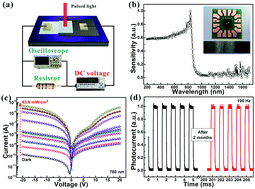A room-temperature near-infrared photodetector based on a MoS2/CdTe p–n heterojunction with a broadband response up to 1700 nm†
Abstract
High-performance infrared photodetectors (PDs) have attracted much attention due to their great significance in military and industrial applications. The improvement of two-dimensional (2D) materials offers an open platform for designing various high-performance PDs, especially in the infrared region, which can overcome the drawbacks of the traditional epitaxial thin film based PDs, such as the complicated preparation processes, low-temperature operating conditions and inability to be miniaturized. In this work, a high-performance infrared PD based on a MoS2/CdTe p–n heterojunction with type-II band alignment was constructed and investigated. This PD showed a broadband photoresponse from 200 nm to 1700 nm, which is far beyond the band-gaps of MoS2 and CdTe. Moreover, a high responsivity, specific detectivity and fast response speed were achieved. These results demonstrate that the MoS2/CdTe p–n heterojunction has great potential in room-temperature infrared detection, and provide a way to design high-performance infrared PDs for other 2D materials.



 Please wait while we load your content...
Please wait while we load your content...